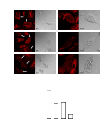Acute stimulation of white adipocyte respiration by PKA-induced lipolysis
- PMID: 20682684
- PMCID: PMC3279548
- DOI: 10.2337/db10-0245
Acute stimulation of white adipocyte respiration by PKA-induced lipolysis
Erratum in
- Diabetes. 2011 Feb;60(2):691
Abstract
Objective: We examined the effect of β-adrenergic receptor (βAR) activation and cAMP-elevating agents on respiration and mitochondrial uncoupling in human adipocytes and probed the underlying molecular mechanisms.
Research design and methods: Oxygen consumption rate (OCR, aerobic respiration) and extracellular acidification rate (ECAR, anaerobic respiration) were examined in response to isoproterenol (ISO), forskolin (FSK), and dibutyryl-cAMP (DB), coupled with measurements of mitochondrial depolarization, lipolysis, kinase activities, and gene targeting or knock-down approaches.
Results: ISO, FSK, or DB rapidly increased oxidative and glycolytic respiration together with mitochondrial depolarization in human and mouse white adipocytes. The increase in OCR was oligomycin-insensitive and contingent on cAMP-dependent protein kinase A (PKA)-induced lipolysis. This increased respiration and the uncoupling were blocked by inhibiting the mitochondrial permeability transition pore (PTP) and its regulator, BAX. Interestingly, compared with lean individuals, adipocytes from obese subjects exhibited reduced OCR and uncoupling capacity in response to ISO.
Conclusions: Lipolysis stimulated by βAR activation or other maneuvers that increase cAMP levels in white adipocytes acutely induces mitochondrial uncoupling and cellular energetics, which are amplified in the absence of scavenging BSA. The increase in OCR is dependent on PKA-induced lipolysis and is mediated by the PTP and BAX. Because this effect is reduced with obesity, further exploration of this uncoupling mechanism will be needed to determine its cause and consequences.
Figures








Similar articles
-
beta-Adrenergic activation of p38 MAP kinase in adipocytes: cAMP induction of the uncoupling protein 1 (UCP1) gene requires p38 MAP kinase.J Biol Chem. 2001 Jul 20;276(29):27077-82. doi: 10.1074/jbc.M101049200. Epub 2001 May 21. J Biol Chem. 2001. PMID: 11369767
-
Acylated and unacylated ghrelin attenuate isoproterenol-induced lipolysis in isolated rat visceral adipocytes through activation of phosphoinositide 3-kinase γ and phosphodiesterase 3B.Biochim Biophys Acta. 2011 Jun;1811(6):386-96. doi: 10.1016/j.bbalip.2011.03.001. Epub 2011 Mar 22. Biochim Biophys Acta. 2011. PMID: 21435395
-
Analysis of inhibition by H89 of UCP1 gene expression and thermogenesis indicates protein kinase A mediation of beta(3)-adrenergic signalling rather than beta(3)-adrenoceptor antagonism by H89.Biochim Biophys Acta. 2001 Apr 23;1538(2-3):206-17. doi: 10.1016/s0167-4889(01)00070-2. Biochim Biophys Acta. 2001. PMID: 11336791
-
cAMP-mediated signaling normalizes glucose-stimulated insulin secretion in uncoupling protein-2 overexpressing beta-cells.J Endocrinol. 2006 Sep;190(3):669-80. doi: 10.1677/joe.1.06723. J Endocrinol. 2006. PMID: 17003268
-
Positive and negative control of Ucp1 gene transcription and the role of β-adrenergic signaling networks.Int J Obes (Lond). 2010 Oct;34 Suppl 1:S28-33. doi: 10.1038/ijo.2010.180. Int J Obes (Lond). 2010. PMID: 20935662 Review.
Cited by
-
β-Adrenoceptor Signaling Networks in Adipocytes for Recruiting Stored Fat and Energy Expenditure.Front Endocrinol (Lausanne). 2012 Jan 3;2:102. doi: 10.3389/fendo.2011.00102. eCollection 2011. Front Endocrinol (Lausanne). 2012. PMID: 22654837 Free PMC article.
-
Protein kinase A induces UCP1 expression in specific adipose depots to increase energy expenditure and improve metabolic health.Am J Physiol Regul Integr Comp Physiol. 2016 Jul 1;311(1):R79-88. doi: 10.1152/ajpregu.00114.2016. Epub 2016 Apr 20. Am J Physiol Regul Integr Comp Physiol. 2016. PMID: 27097660 Free PMC article.
-
Preventing White Adipocyte Browning during Differentiation In Vitro: The Effect of Differentiation Protocols on Metabolic and Mitochondrial Phenotypes.Stem Cells Int. 2022 Apr 5;2022:3308194. doi: 10.1155/2022/3308194. eCollection 2022. Stem Cells Int. 2022. PMID: 35422865 Free PMC article.
-
LXRα fuels fatty acid-stimulated oxygen consumption in white adipocytes.J Lipid Res. 2014 Feb;55(2):247-57. doi: 10.1194/jlr.M043422. Epub 2013 Nov 20. J Lipid Res. 2014. PMID: 24259533 Free PMC article.
-
A role for long-chain acyl-CoA synthetase-4 (ACSL4) in diet-induced phospholipid remodeling and obesity-associated adipocyte dysfunction.Mol Metab. 2018 Mar;9:43-56. doi: 10.1016/j.molmet.2018.01.012. Epub 2018 Jan 31. Mol Metab. 2018. PMID: 29398618 Free PMC article.
References
-
- Brand MD. The efficiency and plasticity of mitochondrial energy transduction. Biochem Soc Trans 2005;33:897–904 - PubMed
-
- Arner P. Insulin resistance in type 2 diabetes: role of fatty acids. Diabete Metab Res Rev 2002;18(Suppl. 2):S5–S9 - PubMed
-
- Nedergaard J, Bengtsson T, Cannon B. Unexpected evidence for active brown adipose tissue in adult humans. Am J Physiol Endocrinol Metab 2007;293:E444–E452 - PubMed
-
- van Marken Lichtenbelt WD, Vanhommerig JW, Smulders NM, Drossaerts JM, Kemerink GJ, Bouvy ND, Schrauwen P, Teule GJ. Cold-activated brown adipose tissue in healthy men. N Engl J Med 2009;360:1500–1508 - PubMed
Publication types
MeSH terms
Substances
LinkOut - more resources
Full Text Sources
Other Literature Sources
Research Materials
Miscellaneous

